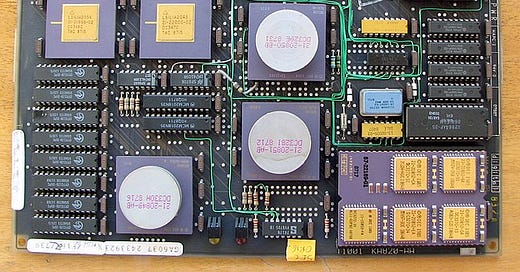The Soul of the Healthcare Machine
It’s 1978, and Tom West is trespassing.
Tom is the lead engineer at Data General, a minicomputer company. His company’s rival - DEC - has just released a hit product. And Tom is beside himself… he needs to get a feel for this thing. Which means being in a room he’s not supposed to be in.
He approaches the computer surreptitiously and lifts up the hood. He counts 27 printed circuit boards. He studies the connections between different components.
“Too complicated…” he mutters.
And then something happens. While Tom is staring at the computer’s architecture, he feels he can see a diagram of DEC’s organizational structure. Each circuit component is a corporate division… with the connections mapping out communication lines.
—-
Tracy Kidder recounts this story in the 1981 book “The Soul Of A New Machine.” And more than 4 decades later, healthcare still hasn’t picked up a clue.
What an elegant concept… that a product’s design could be an expression of a company’s organizational chart. Except that in healthcare, we have deplorably fragmented and bloated systems that give the word “system” itself a bad name.
I’ve gone through the exercise myself, and it’s not pretty. Just try to draw a flowchart of a spine patient’s journey from initial diagnosis to final resolution… it’s a hornet’s nest. Each specialty trying to optimize for itself. No sense of a preordained, efficient pathway. No one zooming out and taking pride in the global process.
It’s like those street markets where you walk through and every vendor just wants to sell you as much of their own stuff as possible. “Hey you! Where are you going? Buy some of this!”
Patients know the maddening labyrinth all too well. We all live it and hate it. And sadly, it is a direct reflection of the haphazard and perversely incentivized (dis)organization of our care models.
In the first year of medical school, we learn that “structure dictates function”. It’s true for human physiology… it’s true in computer design… and it’s true in healthcare delivery.
So what now? I’m a spine surgeon. I’m one of the engineers in Division 6 of the computer company. I’m one of the vendors in the street market. But that’s not good enough anymore. I can’t just put my head down and churn blindly.
Value-based care can be an exhausting phrase. But I think it’s time for us to care about the patient’s care journey, not just our slice of the care. It’s time for us to be architects, not just craftsmen. It’s time to rediscover the soul of the healthcare machine.




